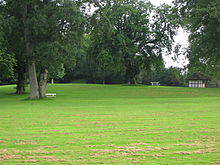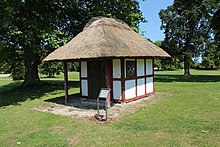Pederstrup
Pederstrup is a listed manor house on Lolland in the parish of Vesterborg Sogn , Denmark . At times it belonged to the Danish crown.
The Pederstrup estate was part of the Christianssæde County of the Reventlow family for almost 200 years . It has been a museum for the social reformer Count Christian Detlev von Reventlow since 1940 .
history
The Pederstrup farm was first mentioned when Laurids Jensen gave it to Halsted Monastery before his death in 1340. The monastery sold the property to King Valdemar Atterdag in 1354 . It thus became the seat of a feudal lord . However, the Crown exchanged Pederstrup for Stadager in Falster in 1576 . The Venstermand family became owners for several generations. It then came to the Brahes by inheritance until 1625 .
In 1625 it went from Holger Rosenkrantz to the Grabow family and from there in 1657 to the Harstalls . The next owner was the court master Cai Rumohr in 1673 , who sold the property again seven years later.
In 1680 Pederstrup was owned by the Danish rent master Heinrich von Stöcken . His sons Cai Burchard and Hans Heinrich , who called themselves von Stöcken zu Pederstrup , sold the property in 1684 to their brother-in-law Peter von Brandt , their father's successor, who was ennobled in 1679. Brandt expanded the land area considerably, on the one hand through the purchase of numerous farms and on the other hand he received donations from King Christian V. By department of Skelstofte he made the operation more efficient. Until 1699 he had received church patronage over Vesterborg , Birket , Horslunde and Nordlunde .
In 1686 Brandt had a new two-story half-timbered building built as the main house. With the stud , built in the 1690s , a Baroque estate was created with an avenue, a park and the lake. Parts of the park still exist despite later redesign.

In 1725 his son Henrik Pederstrup and Skelstofte sold to Count Christian Detlev von Reventlow . He founded the county Christiansborg four years later, which his son renamed Christianssæde in 1741 when Christian VI. gave the Copenhagen Palace the name Christiansborg . The Danish statesman and social reformer Christian Detlev von Reventlow († October 11, 1827 on Pederstrup) made the property the seat of the county in 1813 after retiring into private life. In Lolland and on Pederstrup he had first tried out his agricultural and school reforms on a small scale. - In 1770 the estate had an area of around 620 hectares.
Reventlow had Brandt's main building demolished in 1813 and built a mansion in a simple, classicist style based on plans by the architect CF Hansen by 1822. The blue tile roof gave its name to Det Blå Hus . Together with the yellow Det Gule Hus , an older residential building as well as the new building and the expansion of the stud by two wings, Pederstrup underwent a comprehensive redesign.
Under his grandson Ferdinand and his wife, the property underwent another fundamental redesign from 1858 to 1860. The main house was extended by two wings and two round towers in the style of French castles. The architect Ferdinand Meldahl drew the plans . Since the stud was demolished and rebuilt some distance away in 1868, the landscape park was given a more spacious design by Friedrich Jürgens . Four years later, Denmark's largest privately owned riding arena was inaugurated. A large barn, coach house , stables for guests and a laundry completed the facility. In 1850 the estate covered more than 1000 hectares, a quarter of which was cultivated by the owner.
In 1900 the property was leased and employed 2 administrators, 1 supervisor, 1 forage foreman, 1 foreman, 7 apprentices, 17 servants, 3 girls, 10 day laborers and 39 Polish seasonal workers (above). There were 230 cows, 60 calves, 7 bulls, 45 horses, 7 foals, 5 sheep and about 200 pigs.
The last noble generation of the Reventlow family chose Brahetrolleborg Castle on Funen as their permanent residence and used Pederstrup as their summer residence. From 1919 to 1924 the county Christianssæde became free property. When Count Christian Einar died in 1929, the family's finances came under pressure. His widow and two daughters sold the property on Lolland. The Pederstrup Stud was sold to the Nielsen family in 1935 (now 204 hectares ). The castle and the park, which had been reduced to 20 hectares, were sold to a museum committee in 1938 .
The current main building was rebuilt between 1938 and 1940 by demolishing all the added wings and towers to the state of 1822. Viggo Sten Møller (1897–1990) was in charge . The park was opened to the public in 1939, with two memorials to the owners who died in 1875 and 1929. The retreating German troops took the latter with them in 1945. The Reventlow-Museet Pederstrup in honor of the social reformer opened in 1940.
The coach houses and other outbuildings were demolished in the late 1970s.
The museum is now part of the Lolland-Falster Museum.
description
The mansion in the classicism style was rebuilt by 1940 to the state of 1822. It is a simple building with 13 window axes. Only the middle risk is two-storey.
The large park, designed from 1871 to 1877, contains several rare trees, lakes and a pavilion in a half-timbered house from 1834. The ice cellar, the woman's garden , the west avenue and the baroque lines of sight are elements of the baroque park from the end of the 17th century. In the course of the 20th century, the park was reduced in size and the water areas regretted.
The following are protected as architectural monuments: the manor house, the riding arena of the neighboring stud and the Reventlow asylum in the neighboring village of Horslunde . It was built by Christian Detlev Reventlow in 1824 for poor people.
Reventlow Museum Pederstrup
The Reventlow Museum ( Danish Reventlow-Museet Pederstrup ) is now part of the Lolland-Falster Museum . The manor house and the park belong to it. The exhibition shows furniture, portraits and personal items related to the social reformer Reventlow and his time.
The owners of Pederstrup
- Entire property
- until 1340 Laurids Jensen
- 1340–1354 Halsted Monastery
- 1354–1576 Danish crown
- 1576–1587 Lave Venstermand
- 1587–1606 Knud Venstermand
- 1606–1610 Morten Venstermand
- 1610–1616 Anne Galt married Venstermand, married Brahe
- 1616-1625 Falk Brahe
- 1625 Holger Rosenkrantz
- 1625–1626 Hans Grabow
- 1626–1645 Joachim Grabow
- 1645–1657 Hans Johan Grabow
- 1657–1666 Hans Wilhelm von Harstall
- 1666–1673 Hans Friderich von Harstall
- 1673–1680 Cai von Rumohr
- 1680–1681 Heinrich von Stöcken
- 1681–1684 Cai Burchard, Hans Heinrich von Stöcken and Abigail married. Brandt
- 1684–1701 Peter von Brandt
- 1701–1725 Henrik von Brandt
- 1725–1738 Christian Detlev von Reventlow
- 1738–1775 Christian Detlev von Reventlow
- 1775–1827 Christian Detlev von Reventlow († 1827 on Pederstrup)
- 1827–1851 Christian Detlev von Reventlow
- 1851–1875 Ferdinand von Reventlow
- 1875–1929 Christian Einar von Reventlow
- 1929–1935 heirs to Reventlow
- Mansion and park
- 1935-1938 Reventlow
- since 1938 Reventlow-Museet, Pederstrup - Museum Lolland-Falster
- stud
- since 1935 the Nielsen family.
Web links
- danskeherregaarde.dk: Pederstrup . (Danish, as of September 16, 2019)
- Reventlow Museet . (Danish, website of the museum)
literature
- Steen Estvad Petersen: Danske herregårde. Bygninger - haver - landskaber . København 1980.
- Aage Roussell (ed.): Danske Slotte og Herregårde . København 1965.
- Niels Peter Stilling: Danmarks Herregårde. Sjælland, Møn og Lolland-Falster . Gyldendal 2014.
- JP Trap: Danmark . Volume 4,3: Maribo Office . København 1955.
Coordinates: 54 ° 53 ′ 48 ″ N , 11 ° 16 ′ 4 ″ E






